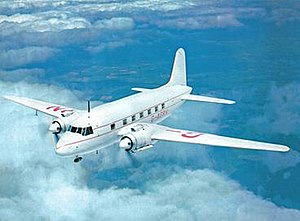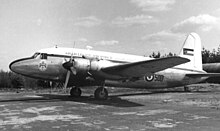
Vickers VC.1 Viking

This article includes a list of general references, but it lacks sufficient corresponding inline citations. (February 2019) |

| VC.1 Viking | |
|---|---|
 Vickers Viking 1A, G-AGRN | |
| General information | |
| Type | Airliner |
| Manufacturer | Vickers-Armstrongs Limited |
| Designer | |
| Status | Retired |
| Primary user | British European Airways |
| Number built | 163 |
| History | |
| Manufactured | 1945–1954 |
| Introduction date | 1946 |
| First flight | 22 June 1945 |
| Developed from | Vickers Wellington |
| Variants | Vickers Valetta Vickers Varsity |
The Vickers VC.1 Viking is a British twin-engine short-range airliner derived from the Vickers Wellington bomber and built by Vickers-Armstrongs Limited at Brooklands near Weybridge in Surrey. After the Second World War, the Viking was an important airliner with British airlines, pending the development of turboprop aircraft like the Viscount. An experimental airframe was fitted with Rolls-Royce Nene turbojets and first flown in 1948 as the world's first pure jet transport aircraft. Military developments were the Vickers Valetta and the Vickers Varsity.

Design and development
The Ministry of Aircraft Production ordered three prototype Wellington Transport Aircraft to Air Ministry Specification 17/44 from Vickers-Armstrongs Limited. The specification was for a peacetime requirement for an interim short-medium haul passenger aircraft to serve until the more advanced designs specified by the Brabazon Committee (in particular, the Airspeed Ambassador and Armstrong Whitworth Apollo) could be developed.[1][2] To speed development the aircraft used the wing and undercarriage design from the Wellington but the fuselage was new.[3][4] Although the original contract referred to Wellington Transport Aircraft, on completion, the name Viking was chosen.[1]

The first prototype (designated the Type 491 and registered G-AGOK) was built by the Vickers Experimental Department at its wartime Foxwarren dispersal site and was first flown by 'Mutt' Summers at Wisley Airfield on 22 June 1945.[5] This aircraft crashed on 23 April 1946[3] due to a double engine failure; no fatalities occurred as a result of the crash.[6] Following successful trials of the three prototypes the Ministry of Aircraft Production ordered 50 aircraft.[3][7] The first BOAC aircraft flew on 23 March 1946. The prototypes were then used for trials with the Royal Air Force which led to orders for military versions (the Viking C2 (12 ordered as freighter/transports) and the modified Valetta C1).


The initial 19 production aircraft (later designated the Viking 1A) carried 21 passengers, they had metal fuselages and - except for the wing inboard of the nacelles - fabric-clad geodetic wings and tail units. Following feedback from customers, the next 14 examples, known as the Viking 1, featured stressed-metal wings and tail units. The next variant, the Viking 1B, was 28 in (71 cm) longer, carrying 24 passengers with up-rated Bristol Hercules piston engines, achieved a production run of 115. One of this batch was changed during production to so that it could be fitted with two Rolls-Royce Nene turbojet engines, with its first flight on 6 April 1948.

On 25 July 1948, on the 39th anniversary of Blériot's crossing of the English Channel, the Type 618 Nene-Viking flew Heathrow–Paris (Villacoublay) in the morning carrying letters to Bleriot's widow and son (secretary of the FAI), who met it at the airport. The flight of 222 miles (357 km) took only 34 minutes. It then flew back to London in the afternoon. It obtained a maximum speed of 415 mph (668 km/h) at 12,000 ft (3,700 m) and averaged 394 mph (634 km/h).[8] In 1954 it was bought from the Ministry of Supply and underwent the substantial conversion to Hercules 634 piston engines by Eagle Aviation to join their fleet.[9]

Production finished in 1948, including 16 for the RAF of which four were for the King's Flight,[10] but in 1952 BEA adapted some to a 38-passenger layout, taking the maximum payload up from 5,500 to 7,200 lb (2,500 to 3,300 kg). All Vikings featured a tailwheel undercarriage.

The 58th Viking (c/n 158) became the prototype of the military Valetta, of which 262 were produced for the RAF. When production of this strengthened but externally similar type ended in 1952, a flying classroom version with tricycle undercarriage was already being delivered to the Royal Air Force (RAF), called the Varsity.[11] All but one of those entered RAF service, the other example going to the Swedish Air Force. The production of 161 Varsities kept the Hurn works busy until January 1954, and they enjoyed a long service life. Six examples are preserved, including at Brooklands Museum,[12] and the Newark Air Museum.[13]

Operational history

The first Viking was flown from Vickers' flight test airfield at Wisley, Surrey, by chief test pilot Joseph "Mutt" Summers on 22 June 1945 and the third aircraft built was delivered to BOAC at Hurn near Bournemouth on 20 April 1946. Upon the delivery of nine examples to BOAC for development flying, including the two remaining prototypes, British European Airways (BEA) was established on 1 August 1946 to operate airliners within Europe and these first VC.1 Vikings were transferred to the new airline.[3]

After a trial flight from Northolt to Oslo on 20 August 1946 by the newly formed BEA, the first regular Viking scheduled service commenced between Northolt and Copenhagen Airport on 1 September 1946.[14]

In all 163 Vikings were built. The initials "VC" stood for Vickers Commercial,[15] echoing the "VC" precedent set by the earlier Vimy Commercial of 1919. Vickers soon ceased to use the 'VC' letters, instead using type numbers in the 49x and 600 series, which indicated the specific customer airline.


BEA operated their large fleet of Vikings on many European and UK trunk routes for eight years. From 1951, the remaining fleet was modified with 36, instead of 27 seats, and named the "Admiral Class". BEA operated the Viking until late 1954, when the last was displaced by the more modern and pressurised Airspeed Ambassador and Vickers Viscount.

BEA sold their Vikings to several UK independent airlines for use on their growing scheduled and charter route networks. Some were sold to other European operators. An ex-BEA Viking 1B was fitted out as a VIP aircraft for the Arab Legion Air Force, mainly for the use of the King of Jordan.[16] Most Vikings had been retired from service by the mid-1960s and there are now only six extant worldwide with two surviving examples in the UK, both being under long-term major restoration.

Variants
- Viking
- Prototypes with two 1,675 hp (1,250 kW) Bristol Hercules 130 engines, three built.
- Viking 1A
- Initial production version with geodetic wings and two 1,690 hp (1,261 kW) Bristol Hercules 630 engines.
- Viking 1
- Production aircraft with stressed skin mainplanes and two 1,690 hp (1,261 kW) Bristol Hercules 634 engines.
- Viking 1B
- Viking 1 with "long nose", 113 built.
- Nene Viking
- One Viking 1B aircraft modified for trials with two 5,000 lbf (22.3 kN) Rolls-Royce Nene I turbojets.
- Viking C2
- British military designation of the Viking 1; VIP transport aircraft for the King's Flight of the RAF.
- Valetta C1 & C2
- Modified design with strengthened floor and large freight door.
- Varsity T1
- Highly modified Valetta design with tricycle undercarriage for navigation and crew training.
Type numbers
- Type 491
- First prototype[17]
- Type 495
- Second prototype[17]
- Type 496
- Third prototype[17]
- Type 498
- Viking 1A for British European Airways.[17] Three later to Argentine Air Force.[citation needed]
- Type 604
- Viking 1B for Indian National Airways with two Hercules 634 engines.[17][18]
- Type 607
- Valetta prototype for Ministry of Supply with two Hercules 230 engines.[18]
- Type 610
- Viking 1B for British European Airways.[17]
- Type 613
- Projected fuel transport variant, not built.
- Type 614
- Viking 1 for British European Airways.[17]
- Type 615
- Viking 1 for the Argentine government with two Hercules 634 engines.[18]
- Type 616
- Viking 1 for Central African Airways.
- Type 618
- Nene Viking for Ministry of Supply.[17]
- Type 620
- Viking 1 for the Argentine government with two Hercules 630 engines.[17][18]
- Type 621
- Viking C2 for the Royal Air Force with two Hercules 130 engines.[17][18]
- Type 623
- Viking C2 for the Royal Air Force with two Hercules 134 engines. Two ordered for use by the King's Flight for a royal tour of South Africa, one aircraft for the King and one for the Queen.[19][20]
- Type 624
- Viking C2 for the Royal Air Force with two Hercules 134 engines. One ordered for use by the King's Flight for a royal tour of South Africa for use by the state officials in 21-seat configuration.[19]
- Type 626
- Viking C2 for the Royal Air Force with two Hercules 134 engines. One ordered for use by the King's Flight for a royal tour of South Africa as a mobile workshop support aircraft.[19]
- Type 627
- Viking 1B for Airwork Limited.[17]
- Type 628
- Viking 1B for DDL with two Hercules 634 engines.[17][18]
- Type 631
- Projected 34-seat variant, not built.[17]
- Type 632
- Viking 1B for Air India with two Hercules 634 engines.[17][18]
- Type 634
- Viking 1B for Aer Lingus with two Hercules 634 engines.[17][18]
- Type 635
- Viking 1B for South African Airways with two Hercules 634 engines.[17][18]
- Type 636
- Viking 1B demonstrator.[17]
- Type 637
- Valetta C1 for the Royal Air Force with two Hercules 230 engines.[18]
- Type 639
- Viking 1 for Hunting Air Transport.[17][18]
- Type 641
- Viking 1 for Suidair International
- Type 643
- Viking 1 for Suidair International with two Hercules 630 engines.[17][18]
- Type 644
- Viking 1B for Iraqi Airways.[17][18]
- Type 649
- Viking 1B for Pakistan Air Force with two Hercules 634 engines.[17][21]
- Type 651
- Valetta C1 for the Royal Air Force with two Hercules 634 engines.[21]
- Type 657
- Viking 1A conversions from Type 498 for BSAAC.[21]
Operators
Civil operators

- Aerolíneas Argentinas
- Argentine Civil Aeronautics Board
- Flota Aérea Mercante Argentina
- LADE
- Aero Transport
- Aero Express Flug[23]
- Aerotour
- Colombus Luftreederei
- Condor
- Deutsche Flugdienst
- LTU International
- Transavia Flug
- Iraqi Airways[23]
- Iraq Petroleum Transport Company[23]
- Bernado Pasquelle
- Government of Mexico
- Governor General of Pakistan. Personal plane of Quaid E Azam Muhammad Ali Jinnah
- Protea Airways
- South African Airways[23]
- Suldair International Airways[23]
- Trek Airways
- United Airways



- African Air Safaris
- Air Ferry
- Air Safaris[23]
- Airwork Services[23]
- Autair
- Bembridge Air Hire Limited
- BKS Air Transport[23]
- Blue-Air
- British European Airways[23]
- British Overseas Airways Corporation (used only by BOAC development flight)
- Eagle Aviation/Eagle Airways[23]
- British International Airlines[23]
- British Nederland Airservices
- Channel Airways
- Continental Air Services
- Crewsair Limited[23]
- Decca Navigator Company
- Dragon Airways
- Eros Airlines (UK)
- Falcon Airways
- Field Aircraft Services[23]
- First Air Trading Company
- Hunting Air Transport[23]
- Hunting-Clan Air Transport[23]
- Invicta Airways / Invicta International Airways
- Independent Air Transport
- James Stuart Travel Limited
- Maitland Drewery Aviation
- Orion Airways
- Overseas Aviation[23]
- Pegasus Airlines
- Tradair Limited[23]
- Trans World Charter[23]
- Vendair Limited
Military operators
- Argentine Air Force - 30 aircraft.[24] One (T-64, ex LV-XFM) used as presidential aircraft from 1948 to 1952.[25]
- Royal Australian Air Force - One Viking C2 in service from 1947 to 1951.
Accidents and incidents
Of the 163 aircraft built 56 aircraft were lost in accidents – the following were some notable accidents:

- 5 April 1948: G-AIVP operated by British European Airways collided with a Soviet Yak-3 near Berlin, 15 killed.
- 21 April 1948: British European Airways Flight S200P (G-AIVE) crashed on approach to Glasgow-Renfrew Airport. No one was killed but 14 were injured.

Wreckage of G-AIVE at the crash site of British European Airways Flight S200P, photographed in situ in 2007 - 8 February 1949: OY-DLU operated by Det Danske Luftfartselskab (DDL) crashed into the sea off Copenhagen, Denmark, with the loss of all 27 occupants.[26]
- 31 October 1950: G-AHPN operated by British European Airways crashed during a Ground Control Approach landing in bad visibility (40–50 yards (37–46 m)) at London Northolt airport, England. The pilot failed to overshoot and 25 passengers and three crew died. It was subsequently recommended that it be an offence for aircraft to go below a minimum height when ground visibility was low.[27]
- 17 February 1952: G-AHPI operated by Hunting Air Travel flew into the La Cinta mountain range, Italy, with the loss of all 31 occupants.[28]
- 5 January 1953: G-AJDL operated by British European Airways crashed on approach at Belfast-Nutts Corner Airport, Northern Ireland, three crew and 24 passengers died.[29][30]
- 12 August 1953: G-AIVG operated by British European Airways crashed on take-off at Le Bourget-Paris, France, four crew and 30 passengers injured but survived.[31]
- 1 May 1957: G-AJBO operated by Eagle Aviation crashed after engine failure near Blackbushe Airport, England, five crew and 29 passengers died.
- 2 September 1958: G-AIJE operated by Independent Air Travel crashed into a house as the flight crew were trying to return to London Heathrow Airport after reporting engine problems. All three crew died and four on the ground also died.[32]
- 9 August 1961: G-AHPM operated by Cunard Eagle Airways crashed into a mountainside near Holta on approach to Stavanger Airport, Sola in Norway with the loss of all 39 occupants.[33] The Norwegian report on the incident[34][35] concluded that the pilot was off-course for unknown reasons. The 50th anniversary was marked by a book published in summer 2011, The Lanfranc Boys by Rosalind Jones, sister of Quentin Green, one of the victims.[36] The aircraft carried 34 boys and 2 members of staff from The Archbishop Lanfranc School in Croydon.
- 11 September 1963: F-BJER operated by Airnautic crashed into a mountain in the Pyrenees with the loss of all 40 occupants, the worst Viking accident.[37]
Aircraft on display


Of the 163 Vikings produced, only six survive today; five can be found in museums around the world, while a sixth airframe was stored at an airfield near Vienna in Austria until dismantled in late April 2023. Acquired by the Blackbushe Heritage Trust, it is returning to the UK in early May for restoration and display at Blackbushe Airport in Surrey.

- Argentina
- T-9 – Viking 1B on static display at the Museo Nacional de Aeronáutica de Argentina in Morón, Buenos Aires.[38]
- Pakistan
- J-750 – Viking 1B on static display at the Pakistan Air Force Museum in Karachi, Sindh.[39]
- Switzerland
- G-AIVG – Viking 1B under restoration to static display by the Vintage Aircraft Club at EuroAirport Basel Mulhouse Freiburg in Basel.[40] It crashed at Le Bourget Airport on 12 August 1958.[41] It uses undercarriage and other parts from Vickers Valetta VX577 destroyed by fire 24 January 1997.[42][failed verification]
- South Africa
- ZS-DKH – Viking 1A under restoration to static display at the South African Airways Museum Society in Germiston, Gauteng.[43]
- United Kingdom
- G-AGRU – Viking 1A under major long-term restoration while on outdoor display at the Brooklands Museum in Weybridge, Surrey.[44]
- G-AGRW – Viking 1A delivered by the Blackbushe Heritage Trust to Blackbushe Airport, Hampshire, on 2nd May 2023 from long term outdoor storage stored outdoors at Bad Vöslau airfield, Austria, for major restoration at this former Viking engineering maintenance base.
Specifications (Viking 1B)

Data from Vickers Aircraft since 1908 [45]

General characteristics

- Length: 65 ft 2 in (19.86 m)
- Wingspan: 89 ft 3 in (27.20 m)
- Height: 19 ft 7 in (5.97 m)
- Wing area: 882 sq ft (81.9 m2)
- Empty weight: 23,000 lb (10,433 kg)
- Max takeoff weight: 34,000 lb (15,422 kg)
- Fuel capacity: 740 imp gal (890 US gal; 3,400 L)[46]
- Powerplant: 2 × Bristol Hercules 634 14-cylinder two-row radial engines, 1,690 hp (1,260 kW) each
- Propellers: 4-bladed de Havilland or Rotol constant-speed propellers, 13 ft 3 in (4.04 m) diameter [46]
Performance

- Maximum speed: 263 mph (423 km/h, 229 kn) at 1,000 ft (300 m)
- Cruise speed: 210 mph (340 km/h, 180 kn) [47]
- Range: 1,700 mi (2,700 km, 1,500 nmi) at 210 mph (180 kn; 340 km/h)
- Service ceiling: 25,000 ft (7,600 m)
- Rate of climb: 1,500 ft/min (7.6 m/s)
- Take-off distance to 50 ft (15 m): 2,550 ft (780 m)[46]
- Landing distance from 50 ft (15 m): 3,900 ft (1,200 m)[46]
See also
Related development

Aircraft of comparable role, configuration, and era


References
- Notes
- ^ a b Andrews and Morgan 1988, pp. 396–398.
- ^ Taylor 1983, pp. 38–39.
- ^ a b c d Taylor 1983, p. 39.
- ^ Jackson 1988, p. 215.
- ^ Andrews and Morgan 1988, p. 398.
- ^ Ranter, Harro. "ASN Aircraft accident Vickers 491 Viking 1A G-AGOK Effingham". aviation-safety.net. Retrieved 21 September 2022.
- ^ Andrews and Morgan 1988, p. 402.
- ^ "First Jet Transport". Flight. Vol. LIV, no. 2066. 29 July 1948. p. 134. Archived from the original on 14 January 2014.
- ^ "Civil Aviation: From Jets to Pistons". Flight. Vol. 66, no. 2382. 17 September 1954. p. 464. Archived from the original on 14 January 2014.
- ^ Owen Thetford (1988). Aircraft of the Royal Air Force (8th ed.). p. 649.
- ^ Green and Pollinger 1955, p. 184.
- ^ "Vickers 668 Varsity T.1". Brooklands Museum. Brooklands Museum Trust Ltd.
- ^ "Aircraft List". Newark Air Museum.
- ^ Chorlton Aeroplane Monthly Winter 2013, p. 81.
- ^ Flight 24 May 1945
- ^ Martin 1975, p. 26.
- ^ a b c d e f g h i j k l m n o p q r s t u Taylor 1983, p. 42.
- ^ a b c d e f g h i j k l m Andrews and Morgan 1988, p. 501.
- ^ a b c Andrews and Morgan 1988, pp. 405, 501.
- ^ Taylor 1983, p. 44.
- ^ a b c Andrews and Morgan 1988, p. 502.
- ^ "Aviameer Airlines". Airline History. Retrieved 8 November 2021.
- ^ a b c d e f g h i j k l m n o p q r s t u v w x y z Taylor 1983, p. 48.
- ^ The Illustrated Catalogue to Argentine Air Force Aircraft, Gaceta Aeronautica, 2013 (accessed 2019-02-16)
- ^ La corta vida de un Viking, Roll Out website, 2011 (accessed 2019-02-16)
- ^ "ASN Aircraft accident Vickers 628 Viking 1B OY-DLU Barsebäck (Öresund)" Archived 30 January 2012 at the Wayback Machine aviation-safety.net.
- ^ "Lessons from an Accident." Archived 2 November 2012 at the Wayback Machine "Flight", 19 October 1951, pp. 218–219. Retrieved: 6 August 2011.
- ^ "ASN Aircraft accident Vickers 614 Viking 1 G-AHPI Monte la Cinta" Archived 24 October 2012 at the Wayback Machine aviation-safety.net.
- ^ "ASN Aircraft accident Vickers 610 Viking 1B G-AJDL Belfast-Nutts Corner Airport" Archived 25 June 2011 at the Wayback Machine aviation-safety.net.
- ^ "Finding of the Nutt's Corner Inquiry" Archived 4 November 2012 at the Wayback Machine. Flight, 31 July 1953, p. 153.
- ^ "ASN Aircraft accident Vickers 610 Viking 1B G-AIVG Paris Le Bourget Airport" Archived 25 March 2017 at the Wayback Machine aviation-safety.net.
- ^ Flight 21 August 1959, p. 58.
- ^ "ASN Aircraft accident Vickers 610 Viking 3B G-AHPM Stavanger" Archived 6 June 2011 at the Wayback Machine aviation-safety.net.
- ^ "Flight International 4 October 1962 "Stavanger Accident Report"". flightglobal.com. Archived from the original on 3 February 2017. Retrieved 25 April 2018.
- ^ "British Pathe News". britishpathe.com. Archived from the original on 29 August 2011. Retrieved 25 April 2018.
- ^ Jones, Chris. "Stavanger Aircrash". lanfranc-holtaheia.co.uk. Archived from the original on 13 September 2017. Retrieved 25 April 2018.
- ^ "ASN Aircraft accident Vickers 610 Viking 1B F-BJER Pic de la Roquette" Archived 4 November 2012 at the Wayback Machine aviation-safety.net.
- ^ "Airframe Dossier - Vickers Viking 1B, s/n T-9 ARA, c/n 163, c/r LV-XET". Aerial Visuals. AerialVisuals.ca. Archived from the original on 25 April 2018. Retrieved 6 June 2017.
- ^ "THE QUAID'S AIRCRAFT". Pakistan Air Force Museum. Pakistan Air Force Museum. Archived from the original on 15 May 2017. Retrieved 6 June 2017.
- ^ "Das Projekt "Save-a-Viking"". Save-a-Viking (in German). Archived from the original on 30 March 2017. Retrieved 6 June 2017.
- ^ "Der Unfall der "G-AIVG"". Save-a-Viking (in German). Archived from the original on 20 November 2008. Retrieved 6 June 2017.
- ^ "Was im Jahr 2010 bei "Save-a-Viking" geschah". Save-a-Viking (in German). Archived from the original on 25 April 2018. Retrieved 6 June 2017.
- ^ "Vickers Viking VC.1A". SAA Museum Society. Archived from the original on 25 April 2018. Retrieved 6 June 2017.
- ^ "Vickers 498 Viking 1A". Brooklands Museum. Brooklands Museum Trust Ltd. Archived from the original on 3 October 2017. Retrieved 6 June 2017.
- ^ Andrews and Morgan 1988, p. 416.
- ^ a b c d Bridgman 1951, p. 92c.
- ^ Jackson 1988, p. 221.
- Bibliography
- "Air Commerce: The Southall Accident: Report of the Public Inquiry". Flight, 21 August 1959, p. 58.
- Andrews, C.F. and E.B. Morgan. Vickers Aircraft since 1908. London:Putnam, 1988. ISBN 0-85177-815-1.
- Bailey-Watson, C. B. "Vickers Viking". Flight, Vol. XLVII, No. 1900, 24 May 1945. pp. 556a–d, 557.
- Bridgman, Leonard. Jane's All The World's Aircraft 1951–52. London: Sampson Low, Marston & Company, Ltd, 1951.
- Chorlton, Martyn. "Database: Vickers VC.1 Viking". Aeroplane, Vol. 41, No. 12, Winter 2013. pp. 74–87. ISSN 0143-7240.
- Green, William and Gerald Pollinger. The Aircraft of the World. London: Macdonald, 1955.
- Jackson, A.J. British Civil Aircraft 1919–1972: Volume III. London: Putnam, 1988. ISBN 0-85177-818-6.
- Martin, Bernard. The Viking, Valetta and Varsity. Tonbridge, Kent, UK: Air-Britain (Historians) Ltd., 1975. ISBN 0-85130-038-3.
- Taylor, H.A. "The Viking... Vickers Commercial One". Air Enthusiast, No. 21, April–July 1983, pp. 38–48. ISSN 0143-5450.
External links
- "First Jet Transport" a 1948 article in Flight
- Progress - The Vickers "Nene/Viking" a 1949 advertisement in Flight for Rolls-Royce engines
See what we do next...
OR
By submitting your email or phone number, you're giving mschf permission to send you email and/or recurring marketing texts. Data rates may apply. Text stop to cancel, help for help.
Success: You're subscribed now !


